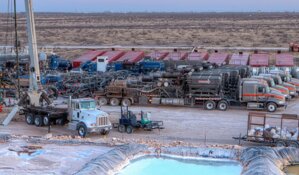Quinn Kiley: Our business is built around providing custom solutions to individuals and institutional investors. Unlike a lot of the other MLP investors, MLPs are only one of the things we do. We also have a significant fixed-income business and a significant large-cap core equity business. The vast majority of our business is on the institutional side.
As you know, MLPs have, historically, been the purview of taxable retail investors. Our history in that space developed along those lines, too. We manage separate accounts for high net-worth individuals. We also offer that strategy through several broker/dealers, whereby their clients have access to our strategies and we manage the accounts for them. We do the same thing for some institutions and closed-end funds—we run the portfolios for those funds.
TER: With T-bills fetching record low yields and MLPs averaging almost 7%, is it easier to sell investors on MLPs now or do you still need to educate them about being in MLPs?
QK: It's now easier to have a conversation about MLPs because they are much more in the front of people's minds. However, the understanding about what an MLP is, how it fits in a portfolio and why it makes sense for a range of investors is still a topic that we have to cover in most of our meetings. MLPs are a growing asset class that is becoming more prominent, as entities like The Energy Report are discussing the topic in depth. The conversations are still ranging from introductory to deeply analytical, depending on the sophistication and knowledge of the investor you're talking with.
TER: Are you seeing a change in the type of investor being drawn to MLPs?
QK: For 15 years, the firm has been managing MLP portfolios for taxable high net-worth investors and, more recently, for institutions. Over the last five or six years, we've really seen an evolution in the MLP space with the advent of the closed-end funds that were launched in 2004 and 2005. Those funds initially brought institutions into the asset class. Interest in MLPs has continued to grow, and we've seen significant funds raised this year in closed-end funds. We've seen several other MLP vehicles, as well. Periodically, we've seen hedge fund interest. We've seen name-brand mutual fund interest, and that is growing, but it's been a small piece of the overall pie.
Retail investors still make up about 70% of the space; but, with the attractive yields of MLPs relative to everything else, we're seeing a lot more institutional interest. We're moving in that direction. It's part of the evolution of every asset class.
TER: What are some other noteworthy trends over those 15 years?
QK: The MLP asset class today is not what it was 10–15 years ago. Back in the late 1990s, there was only a handful of MLPs to choose from. They were all generally very conservative energy infrastructure MLPs handling oil-refined products, natural gas, natural gas liquids (NGLs) and propane. And there was a broader group of MLPs that was phasing out of the MLP structure as they reacted to regulatory changes.
In the last decade, we've seen MLPs really deliver total returns based on fundamental growth by acquisitions or by constructing new assets. But we've also seen an expansion of the risk spectrum inside the MLP space as new subsectors have been added. For example the oil- and gas-producing MLPs, which have significant commodity price risk. The asset class has grown not just in number, but also in terms of potential risk and opportunities. Today more than ever, an investor needs some sort of professional advice when investing in the space.
TER: We've talked about where MLPs have been and where they are now. Where is asset class headed?
QK: I think we're at the beginning of the institutionalization of the MLP asset class. MLPs are a smaller asset class, about a $190 billion market capitalization. The liquidity is improving; the reporting has been improving for years. Governance has been improving, too. But more importantly, we're getting to the point where there is enough scale for an institutional investor to invest. That was not true even five years ago.
If you look at the way Real Estate Investment Trusts (REITs) evolved, they provided a tax advantage structure that made it logical to capitalize real estate in that form. I think that's true of MLPs today. But, today, you're seeing new assets being formed in the MLP structure. You're seeing MLPs being the buyer of choice in certain parts of the energy world. You're seeing MLPs being the builder of choice for most of the pipelines in the U.S. Combine this stable cash flow growth with high yield and lower correlation and you have an asset class institutional investors should find attractive.
As MLPs grow and take advantage of those opportunities, the liquidity will increase. And the opportunities for investors will increase. I think we're at the early stages of the maturing of this asset class.
TER: You mean they're acting like more typical equities.
QK: Clearly. They have some fundamental characteristics that make them look a lot different from the broader market; but, in times of stress (like we saw in the fourth quarter of 2008), MLPs correlated very highly with the broader equity markets. Over the long term, because of the tax structure and the stable underlying cash flow of the majority of MLPs, they tend to break away from the herd and demonstrate lower correlation over longer periods of time. I don't think that's going to change. But they are a traded equity, and they're susceptible to the things all traded equities are susceptible to.
TER: MLPs have typically been regarded as low-beta investments or investments that are not subject to massive price swings. However, in July and August, we saw price swings of greater than 1% on 9 days, and 2 days exceeding 2%. And the Alerian MLP Index (NYSE:AMZ) fell by 5% over 4 days' trading in early August. What's happening?
QK: If you look at MLPs at the end of last quarter, I think the projected beta vs. the S&P and the measured data were both about 0.75, so they are generally lower beta than the S&P 500 for some of the reasons I already mentioned. I think it would be misleading to suggest that something evolutionary is happening. The reality is that you don't have nearly 20% annualized returns over a 15-year period if you don't have significant price moves. Though substantially driven by yields and growth in those yields, those gains are also largely driven by price moves. Although the MLP market of yesteryear was, perhaps, more stable and more yield-driven, we have had significant volatility in the last decade over shorter periods.
If you look back over the last 15 years of MLPs, there have been five cycles of bull and bear markets. In many cases, the bear market starts with too much new equity being sold into the market. In the fourth quarter of 2005 you saw an excess of IPOs. In 2007 and 2008, you had levered hedge funds indiscriminately selling. At the beginning of August this year, over a very tight time span, the asset class saw an IPO and a significant number of secondary offerings come to the market. The market didn't have time to digest them, and you saw supply overwhelm natural demand for a short period of time. But, generally speaking, I think the volatility mirroring that of equities is not new to the MLP asset class and is probably what we should expect going forward.
TER: I think it's interesting that, as MLPs are run more like typical companies, their performance in the market is starting to mirror that. Last week, the Fiduciary & Claymore MLP Opportunity Fund (NYSE:FMO), a closed-end fund, conducted a public offering of 4.25 million shares. These closed-end funds are quietly known as "roach motels" because you can check your capital in but you can't easily check it out. Tell us about the upside of being in these funds.
QK: We sub-advise for two MLP-focused closed-end funds, FMO and the MLP Strategic Equity Fund Inc. (NYSE:MTP). Both of those funds are broader MLP-focused closed-end fund products. Calling these funds "roach motels" is a misnomer and, frankly, an injustice to those investors who have taken advantage of the MLP asset class through these vehicles. This isn't someone who, typically, is allocating $5M to the MLP space. It's someone who's buying as little as 1 share and as many as 100,000. They want to do it without incurring additional accounting and tax paperwork. They're trading complexity for the simplicity of buying MLPs through a closed-end fund. There's a fee associated with that structure, but it meets investors' needs.
MLPs span a wide spectrum of capitalization from $20 billion market caps down to $100 million. They can trade from many millions of dollars in units a day to very few thousand dollars. A closed-end fund is, generally, more liquid than many MLPs and less liquid than others. The reality is an investor's ability to get cash out of a closed-end fund is no different than buying any share of any stock whether it is AT&T Inc. (NYSE:T), Kinder Morgan Energy Partners, L.P. (NYSE:KMP) or Exterran Holdings Inc. (NYSE:EXH), a smaller MLP. Liquidity should be a consideration for all investors, whatever they're buying.
TER: So what are some closed-end fund advantages?
QK: If you think about the closed-end fund universe, there are maybe nine dedicated closed-end MLP funds that are nearly 100% invested in a portfolio of MLPs. I would say there are four advantages of being in closed-end funds:
- Access to liquidity in the broader market on a scale that institutional size creates. Whether that's buying blocks of units as they trade on the open market or getting allocations following IPO offerings, it's access that an individual investor would not have.
- Closed-end funds are all professionally managed by some of the leading investors in the MLP space. That allocates some of your risk in terms of stock selection toward professional management.
- You own a single security that is a closed-end fund share but you're getting exposure to 20–50 MLPs. To do that as an individual would get you 20–50 K1s and multiple state tax filing issues (closed-end fund unit holders receive one 1099 for each fund in which they hold units). That's a headache that a lot of investors don't want, especially in tax-exempt settings.
- Many of these closed-end funds have historically bought restricted shares or units of MLPs that are issued at a discount-to-market price. And because the pools of capital are dedicated to the MLP space, they can take a less liquid security and be good holders of it over a longer period of time. For example, if you were a typical retail investor, you wouldn't be able to participate in a private placement buying Plains All American Pipeline, L.P. (NYSE:PAA) at a 3% discount to the market price.
QK: Since its inception, the Alerian Index has returned approximately 16% annually. Over that same timeframe, our MLP composite has annualized returns of 18% gross of fees. I think it's important to put what happened over that time period and what's going to happen over the next 10–15 years in perspective. We, as a firm, don't believe MLPs will earn 20% a year into infinity. Our view is that we've had a significant spree of necessary infrastructure investment in this country, and MLPs have benefited very much from that. But over those 10–15 years, we've effectively been in a long-term falling interest rate environment. As a yielding security, MLPs benefited from that. Going forward, we expect interest rates are going to turn around and start rising; it's probably going to be next year or later depending on what the economy does. That is going to have an impact on all yielding securities. Our view is that MLP returns will have a yield of around 7%, plus long-term distribution growth of 4%–6%. That means a low double-digit return, which we think is attractive in any market but not as attractive as MLP returns over the last 10 years.
TER: What are some of your favorite MLP names poised for growth?
QK: As I mentioned, there's a broader suite of MLPs available for investment. I thought it would be interesting to talk about three very different MLPs.
Regency Energy Partners, L.P. (NASDAQ:RGNC) is probably more widely held and followed than the others. Regency has gone through several transformations; it was originally launched with a general partner (GP) that was owned by a private equity firm. Most of the transformations have centered on where the GP was going to take Regency. Historically, it was a gathering and processing MLP with higher-than-average commodity price exposure, located in northern Louisiana and in the mid-continent region. Control of that entity later transferred to General Electric Company (NYSE:GE), which had a significant suite of investments in the infrastructure world. General Electric's ability to finance large-scale projects and its ownership of significant pipelines led people to believe Regency would become a pipeline MLP.
Consensus on the Street was that that's where it was going and it should be valued that way. We thought valuation had gotten ahead of itself. The correction we saw in 2008 kind of righted that ship and was overly punitive to the name. Meanwhile, they were building out their pipelines and marching toward an impressive suite of Haynesville Shale assets—one of the more exciting shale plays. Then GE sold its interest in the GP to Energy Transfer Partners, L.P. (NYSE:ETP), a well-respected, high growth-oriented MLP that is diversified on the gas and propane side. But ETP used a gas pipeline it owned as currency to fund the transaction. Now, Regency is a diversified natural gas MLP that has pipeline and gathering and processing exposure and some compression. Regency has a footprint that sits right over top of the Haynesville Shale. Its story illustrates how MLPs have evolved from smaller private equity or corporate-sponsored entities into larger-scale, growth-oriented entities.
TER: And the next one?
QK: Looking at the coal subsector, a name we have always been a big supporter of is Alliance Resource Partners, L.P. (NASDAQ:ARLP). There are four coal MLPs right now—two run the operations and two are royalty plays. They own the coal themselves, but they don't do the mining. Alliance does the mining. They either own the reserves or lease them. They control the operations and they, effectively, control their destiny. Because it happens to be in the hands of a very strong management team, Alliance has delivered very well on the value proposition it offers. It's been able to buy and operate successful mining operations, create new mines on previously undisturbed reserves and grow its distribution over the long term. The company's done it with a very conservative coverage ratio, which is just the difference of cash available for distribution over the amount of cash actually distributed from the partnership. The higher that coverage ratio, the more conservative the approach. With direct commodity price exposure, a coal miner or an oil and gas producer should probably have a higher coverage ratio relative to a pipeline that may have very little commodity price exposure. We think Alliance does a very good job of managing that.
More importantly, unlike every other MLP, Alliance reserves enough cash to actually fund its growth. Historically, the vast majority of its growth has been funded by the cash it reserved, as well as on the credit side of their balance sheet. Alliance is not a serial issuer of equity. As you know, sometimes issuing too much equity can be bad for the performance of the underlying MLP; so Alliance has done a couple of things that make a lot of sense to us. It's profitably managed its business, delivered growth—and done it with a very strong balance sheet and conservative approach to its distributions, which we like. It also gives them dry powder for future opportunities and future distribution increases. With several of its mines having come online last year and through to 2011, we expect them to be in a position to continue to deliver growth. The one caveat to all this is that coal is in the crosshairs of the policymakers and environmentalists. We've seen some negative impact through that in the Appalachian area where Alliance has some operations; but they tend to be more focused on the Illinois basin, which has been a little more coal friendly.
TER: You said three, what was the other one?
QK: The third one is Inergy, L.P. (NYSE:NRGY)—an MLP that, historically, was a retail propane provider. They've evolved into a diversified company that has propane as a core business, as well as some pipelines and natural gas storage. Interestingly, they've done it in an area of the country that has a lot of demand for natural gas—the Pennsylvania/New York region. But, maybe more importantly, they are in the Marcellus Shale, which is another large shale play that's very exciting for energy investors. Inergy happens to be sitting right in the middle of it and has access to the New York and New England markets.
We think that they've done a good job of evolving their model over time. One of the reasons I think it's interesting to talk about them is they're a well-run company that's delivered a lot of growth. But they're going through a restructuring whereby NRGY is acquiring the GP, Inergy Holdings, L.P. (NYSE:NRGP), and they are doing it because they believe it's a cost-to-capital advantage over the long term. It's a wait-and-see on Inergy. They have attractive core businesses with good assets and a good footprint, but their structuring issues have created some uncertainty.
TER: It's noteworthy that the bigger company acquired its GP. That seems to be something of a trend in the space.
QK: Well, it has been happening over the last two years at an increasing rate. Often, the rationale is—because of the amount of cash flow that must flow to the GP, it's incrementally more difficult to raise the distribution to the limited partner (LP), which is where the majority of the assets sit. LPs tend to say: "Let's eliminate it!" But they usually do it by buying GPs at a very high multiple. The result is that the near-term recapitalization has near-term negative implications. But the transaction is done with the longer-term view that, as growth resumes, they'll be able to pass more of the cash flow growth to the LP investor. We've seen this happen several times. I think we honestly have to take a step back and say: I understand why this makes sense, but over the long run have we really seen an incremental increase in distributions to the LPs? Time will tell. But with the uncertainty in tax policy going on in Congress, there's a lot of incentive for people to do this now—as opposed to waiting for a new tax regime in which they don't know how they'll be treated. I think there's a tax part of this that's really driving a lot of these transactions.
TER: What are some MLP names that may not have the brand equity of some of the bigger names but have significant growth catalysts?
QK: As far as existing MLPs that have done a good job of delivering growth and have some opportunities, I think you have to look into the gathering and processing space. That group has had phenomenal performance over the last year and a half but was just absolutely crushed in the selloff of 2008. These names have yet to fully recover—names like MarkWest Energy Partners, L.P. (NYSE.A:MWE), which is about a $2.5 billion market cap. They have opportunities inside the Marcellus Shale. You look at Targa Resources Partners, L.P. (NYSE:NGLS), with a little less than a $2 billion market cap, it is really well positioned in the natural gas liquids market and the logistics business. We think they have near-term opportunities, as well.
Quinn T. Kiley is the senior portfolio manager of FAMCO's Master Limited Partnerships product and is responsible for portfolio management of the firm's various energy infrastructure assets. Mr. Kiley serves a portfolio manager for the Fiduciary/Claymore MLP Opportunity Fund and the MLP and Strategic Equity Fund, Inc. Prior to joining FAMCO in 2005, Mr. Kiley served as VP of Corporate and Investment Banking at Bank of America Securities in New York. He was responsible for executing strategic advisory and financing transactions for clients in the energy and power sectors. Mr. Kiley holds a BS with Honors in Geology from Washington and Lee University, an MS in Geology from the University of Montana, a Juris Doctorate from Indiana University School of Law and an MBA from the Kelley School of Business at Indiana University. Mr. Kiley has been admitted to the New York State Bar.
Want to read more exclusive Energy Report interviews like this? Sign up for our free e-newsletter, and you'll learn when new articles have been published. To see a list of recent interviews with industry analysts and commentators, visit our Expert Insights page.
DISCLOSURE:
1) Brian Sylvester of The Energy Report conducted this interview. He personally and/or his family own shares of the following companies mentioned in this interview: None.
2) The following companies mentioned in the interview are sponsors of The Energy Report or The Gold Report: Energy Transfer Partners.
3) Quinn Kiley: I personally and/or my family own shares of the following companies mentioned in this interview: Fiduciary/Claymore MLP Opportunity Fund, General Electric, Plains All American and Exterran. I personally and/or my family am paid by the following companies mentioned in this interview: Fiduciary Asset Management.
Visit The Energy Report’s MLP Insights to learn more.













































